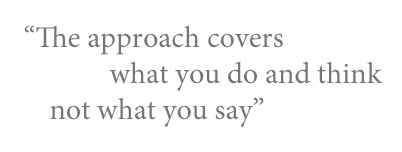The most often quoted and the most incorrect statement in customer service.
And it turns out years later it’s the most accurate.
For years we’ve thrown this statement at one another, refused and denied it. Yelled it from the rooftops and raged at every manager, CEO and executive who used it as a battlecry to please the masses. But we’ve all been wrong. Everyone who used it, did so incorrectly. And all of us who rejected it were wrong. The reality is the customer is always right, but not in the way that people think.
Perception
The customer is right because their complaint is theirs.Not yours. It could be your product and service. But the complaint, the issue the customer wants to raise is entirely theirs and they can’t possibly be wrong about it. Whether the customer believes they purchased a product for exclusive use of a feature that doesn’t exist, or a salesperson told them something that would never have been said is irrelevant. The situation as it stands is about that feature, or that statement being made.
Taking the right approach is paramount. And the approach covers what you do and think, not just what you say.
From the first interaction, those first words you utter or type it will be apparent to the customer (and in social anyone else reading it) just how you see it. And let’s be clear. You are the company.
Customer Service
It comes down to customer service. Good customer service has nothing to do with the outcome. Giving someone what they want isn’t good service. Someone’s experience dictates how good the service they received was, and thats where our approach makes all the difference. If a customer comes to you with a complaint that they purchased product X and it didnt have Y feature. You can resolve it the situation with another product or a refund, which could be much worse customer service than a discussion and explanation.
If the customer is wrong? They’ve asked for a feature the product doesn’t have, and now believe it should. You tell them they are wrong, the feature doesn’t exist, they can’t have been offered it, can’t have seen it. Refund them or refuse. Either option is incredibly poor service. The customer, and anyone else seeing or hearing the interaction has a clear indication of how you’ll approach things.
If the customer is right? They’ve asked for a feature the product doesn’t have and now believe it should. You ask them how they thought it was included, that the feature doesn’t exist. Find out how they’ve been offered it, address that. Did they ask? Not ask? Do they want to perform a specific task that they either don’t need to do? Or is there an alternative? Refund them or not. Either option is great customer service. This time the customer or anyone else seeing it knows how you approach things.
Who’s side of the fence?
The customer being right is based on their perception not yours. The things you needed to do, but didn’t. The things you said without saying them. The information the customer told you without telling you anything.
Let’s step through our example. Customer approaches a store to buy a new tv. During the conversation the customer points out that his wife loves videogames, plays the new ones, the old ones, all of them. Picks out a tv and keeps bringing it up. This plays videogames right? Of course it does, it’s a tv. Just a picture. You pick the right tv, make the sale and send them home.
 24 hours later, an irate customer returns to the store. The TV is useless. Their video games don’t work. Turns out the customers wife plays old video games. 25 year old video games with coax connecters and low res tv signals. This HD flatscreen doesn’t support either of those. And the ones without cables? They play via an old computer plugged into the tv. The new flatscreen doesn’t have a VGA input either. None of this is going to work.
24 hours later, an irate customer returns to the store. The TV is useless. Their video games don’t work. Turns out the customers wife plays old video games. 25 year old video games with coax connecters and low res tv signals. This HD flatscreen doesn’t support either of those. And the ones without cables? They play via an old computer plugged into the tv. The new flatscreen doesn’t have a VGA input either. None of this is going to work.
We can tell the customer they wont be supported. None of the TV’s here will support that. Coax is a thing of the past except for antenna inputs and those are locked. How could you have known they wanted that, they never told you. It’s not an option. It doesn’t do what you want, so we’ll refund it. Even though you never told us you needed this old technology.
But they did tell you. They stated outright what they wanted to do. The details don’t matter.
The customers side of the fence? I need to play my 25 year old video games of X, Y and Z on this TV. They plug right into the TV I already have. A newer tv will add more features. So this will work plus more.
Your side of the fence? I need to play video games on my tv. Everyone plays video games. Just like the ones you sell here.
Now you shouldn’t have asked more. At no point am I suggesting you complicate a simple sales process by asking every customer if the object they want to connect is a 25 yr old video game. But you can ask now.
How often do you play these? How important is it? Did you know none of these tv’s can do that anymore? But there are other options available for you… You can buy X to do that now, we can order that for you. This is a quick look at how this technology works and how those did. We’ve overlooked it because of X, but we can do Y or refund and move on.
 This could mean extra sale of the other device. It could still mean a refund, but the customer has a very different experience. Whether they decide to stay with you or not, they know more. They know ever so little about the technology they use and will use that for future purchases. Tiny differences in detail. Who cares about frequency and resolution and how it tied together. The simple thing the customer needs to know? That their video games connect in a way that some TV’s dont support. And that’s enough to not make this mistake again.
This could mean extra sale of the other device. It could still mean a refund, but the customer has a very different experience. Whether they decide to stay with you or not, they know more. They know ever so little about the technology they use and will use that for future purchases. Tiny differences in detail. Who cares about frequency and resolution and how it tied together. The simple thing the customer needs to know? That their video games connect in a way that some TV’s dont support. And that’s enough to not make this mistake again.
The approach and the outcome are incredibly different. Even with the same result.
The customer is always right. Sometimes we need to know just what it is they’re right about.
8 Responses to The customer is always right